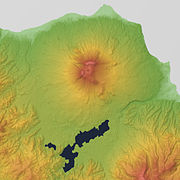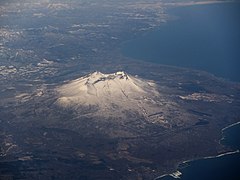You can help expand this article with text translated from the corresponding article in Japanese. Click [show] for important translation instructions.
|
| Mount Hokkaidō-Komagatake | |
|---|---|
| 北海道駒ヶ岳 | |
 View from Lake Ōnuma (August 2008) | |
| Highest point | |
| Elevation | 1,131 m (3,711 ft) |
| Listing | List of mountains and hills of Japan by height List of volcanoes in Japan |
| Coordinates | 42°03′48″N 140°40′38″E / 42.06333°N 140.67722°E |
| Naming | |
| Language of name | Japanese |
| Geography | |
| Topo map(s) | Geographical Survey Institute 25000:1 駒ヶ岳 50000:1 室蘭 |
| Geology | |
| Rock age | Quaternary |
| Mountain type | stratovolcano |
| Volcanic arc/belt | Northeastern Japan Arc |
| Last eruption | September to November 2000 |
Hokkaidō Koma-ga-take (北海道駒ヶ岳, Hokkaidō Koma-ga-take), also Oshima Koma-ga-take (渡島駒ヶ岳), Oshima Fuji (渡島富士), or just Koma-ga-take (駒ヶ岳) is a 1,131 metres (3,711 ft) andesitic stratovolcano[1] on the border between Mori, Shikabe, and Nanae, all within the Oshima Subprefecture of Hokkaidō, Japan.
Occurrence of volcanic activity started some 30,000 years ago. Following roughly 5,000 years of dormancy, volcanic activity at Mount Koma-ga-take restarted in 1640,[2] triggering the Kan'ei Great Famine.[citation needed] Since then, there have been at least 50 recorded volcanic events at Mount Koma-ga-take.[3]
-
Relief Map
-
Viewed from NW.
-
Viewed from ESE.
- ^ "HOKKAIDO KOMA-GA-TAKE". Quaternary Volcanoes of Japan. Geological Survey of Japan, AIST. 2006. Archived from the original on 2012-12-19. Retrieved 2009-06-22.
- ^ Takahashi, Ryo (March 2022). "Mineralogical and geochemical investigations for subvolcanic hydrothermal alteration environments at an active volcano: An example of Hokkaido-Komagatake volcano, Japan". Journal of Volcanology and Geothermal Research. 423. Bibcode:2022JVGR..42307497T. doi:10.1016/j.jvolgeores.2022.107497. S2CID 246616567. Retrieved January 10, 2024.
- ^ 神沼克伊,小山悦郎 日本の火山を科学する 日本列島津々浦々、あなたの身近にある108の活火山とは? ソフトバンククリエイティブ 2011. ISBN 978-4797361308.



